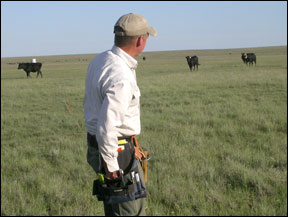 THE ROOTS OF THE GRAZING RESPONSE INDEX
THE ROOTS OF THE GRAZING RESPONSE INDEXAs some of you may know, the Grazing Response Index (GRI) was introduced in 1999 by the Colorado State University Range Extension Program, to help land managers better evaluate the effects of grazing on plants. As quoted from the Rangelands Journal article (August, 1999) written by Reed, Roath, and Bradford; “[The GRI] allows managers to evaluate a number of factors in a simple yet effective manner. It provides feedback to managers quickly.”
Since 1994, Land EKG has field- trained over a thousand land managers to use a variety of “cowboy smart” tools to quickly track, verify, and improve their land conditions. When the GRI was first introduced, it very naturally fit with our ideals of smart, efficient monitoring, and we knew it could play a key role in helping people understand the “core” grazing management principles. We’ve since integrated the GRI into our EKG trainings and have been using and teaching principles from the GRI for almost ten years.
BRUSHING UP ON THE GRAZING RESPONSE INDEX
For those not familiar with the GRI, it is essentially a simple report card for applied grazing management practices. At the end of the season, or the end of a grazing event, managers rate the following three factors:
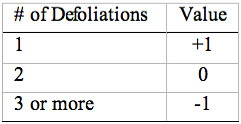
Frequency:
Considers the potential for re-grazing on re-growing plants – a function of grazing duration and rate of grass growth. Scored from -1 to +1.
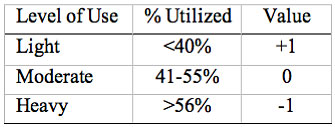
Intensity:
Considers how much forage is consumed – a function of stocking rate.
Scored from -1 to +1
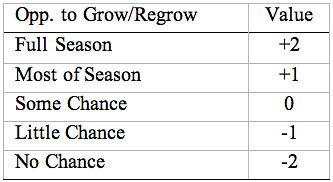
Opportunity/Rest:
Considers the amount of time plants have to grow prior to grazing, or the period of rest following grazing (recovery) – a function of season of year.
Scored from -2 to +2
Keeping a tally of these factors for each pasture, gives managers a final score between -4 and +4, with the more desirable scores being in the positive numbers. The grazing index has been a useful tool to not only assess grazing management annually, but to use as a decision base for improved management practices.
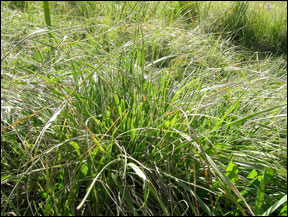 WHY WOULD WE MODIFY THE GRAZING INDEX?
WHY WOULD WE MODIFY THE GRAZING INDEX?After ten years of using the Grazing Index in our everyday work, we recognized that to be more realistic and hopefully more accurate, this index needed to consider: 1) precipitation, and 2) mounting research relating to plant physiology.
Therefore, this year after some hard thought, we began applying this new EKG Grazing Index which has been adapted from the concepts of the original GRI.
THE MAJOR CHANGES: ADAPTING THE OLD GRI INTO THE NEW EKG GRAZING INDEX
In short, the EKG Grazing Index continues to use two attributes of the original GRI (Intensity and Rest/Opportunity) and incorporates two new attributes (Season of Grazing and Precipitation):
- We REMOVED the FREQUENCY factor. This modification will result in fewer plant physiology “debates” relating to “how roots and foliage re-grow in response to grazing”. The concept of Frequency can still be applied into the Opportunity/Rest factor.
- Frequency has been REPLACED WITH a SEASON OF GRAZING factor, which considers plant/grazing stress during different stages of growth. This thinking comes from increasing research (mostly from Washington and Nebraska) on the relationships between timing of grazing and plant reproductive stage.
- We ADDED a new PRECIPITATION factor which will essentially modify the final grazing index score up one for above average years, and down one for below average years, making the final index scale between -5 and +5 rather than -4 and +4. This factor adds emphasis on the need to adjust management based on growing season rainfall.
Though still subjective, we are convinced this new index will more appropriately predict grazing effects on range and pasturelands, while still providing effective options to improve overall management practices.
USING THE EKG GRAZING INDEX
Tallying up the scores from these 4 categories will give you a final grazing index score on a scale of -5 to +5. Consistent with the old GRI, it is preferred to have scores in the positive numbers.
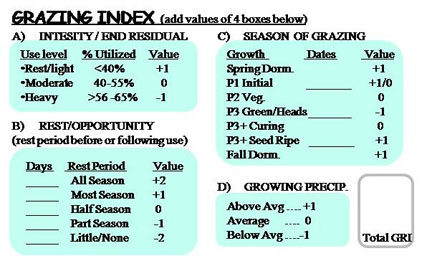
INTENSITY / END RESIDUAL (value of +1 to -1)
Remaining plant residue (residual) is vital for ground cover (litter). We usually consider the amount of residual at season end (some agencies consider this shortly after leaving the pasture) compared to how much grew. Grazing cages or height/weight cards are helpful for this comparison. The more residue remaining = the lower the use (utilization) = the higher the score, and vice versa.
REST / OPPORTUNITY (value of +2 to -2) – twice the value (importance) of any other factor
As discussed in the spring newsletter, adequate plant recovery following grazing is the most important attribute to consider. Plants simply need enough time to grow prior to grazing, or re-grow following grazing. Ask how much growth opportunity/rest your pasture plants received before/following grazing? When considering rest and recovery, it may take longer than you think for plants to be fully recovered. Shorter grazing periods usually increase the opportunity score. When dealing with arid or semi-arid conditions (<20″ annual precipitation) all season rest = +2, most of season rest = +1, half season rest =0, etc.
For irrigated, sub-irrigated, or high rainfall areas, plant re-growth is naturally much faster, and thus it is more appropriate to consider days of rest rather than seasonal length rest periods. For example: In some areas 60 days rest could = All Season(+2), 30 days = Half Season(0), etc. , in even higher rainfall areas 45 days could = All season (+2), 23 = half season(0), etc. It is important for managers to know or determine the appropriate rest periods for their local environments.
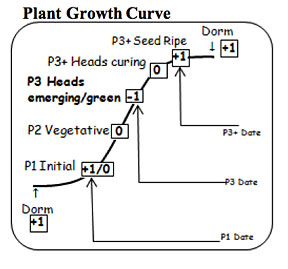
SEASON OF GRAZING (value +1 to -1)
Based on increasing information, grazing appears to stimulate grasses most during early season grazing or anytime following the seed ripe stage. Grazing during vegetative growth, or more importantly green reproductive growth, is less beneficial to grass vitality. The image to the right represents a plant growth curve during the year. Fill in your dates for this year’s growth stages (it may vary each year), and determine score based on the timing of herd grazing.
Does this mean, don’t graze during green reproductive growth? No, but it does support the old grazing adage “avoid grazing your pastures at the same time every year”.
This will spur folks to pay more attention to their stages of grass growth when it comes to grazing.
IN OUR NEXT LAND EKG E-NEWSLETTER ISSUE:
EKG DataStore: Getting Serious about Monitoring
If you have any suggestions for future issues, have feedback, or want more information please contact us at:
(307) 366-2445 or contact us by email.
